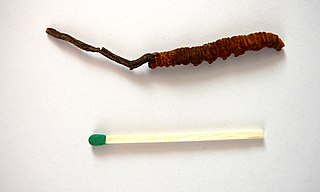
Ophiocordyceps sinensis, known colloquially as caterpillar fungus, is an entomopathogenic fungus in the family Ophiocordycipitaceae. It is mainly found in the meadows above 3,500 metres (11,500 ft) on the Tibetan Plateau in Tibet and the Himalayan regions of Bhutan, India, and Nepal. It parasitizes larvae of ghost moths and produces a fruiting body which is valued in traditional Chinese medicine as an aphrodisiac. Caterpillar fungus contains the compound cordycepin, an adenosine derivative. However, the fruiting bodies harvested in nature usually contain high amounts of arsenic and other heavy metals, so they are potentially toxic and sales have been strictly regulated by China's State Administration for Market Regulation since 2016.
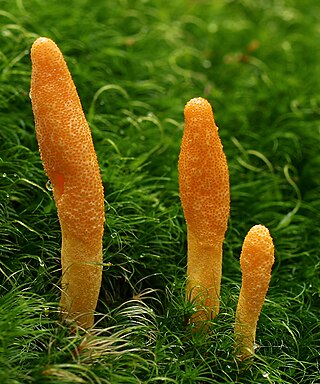
Cordyceps is a genus of ascomycete fungi that includes about 600 worldwide species. Diverse variants of cordyceps have had more than 1,500 years of use in Chinese medicine. Most Cordyceps species are endoparasitoids, parasitic mainly on insects and other arthropods ; a few are parasitic on other fungi.

Verticillium is a genus of fungi in the division Ascomycota, and are an anamorphic form of the family Plectosphaerellaceae. The genus used to include diverse groups comprising saprobes and parasites of higher plants, insects, nematodes, mollusc eggs, and other fungi, thus the genus used to have a wide-ranging group of taxa characterised by simple but ill-defined characters. The genus, currently thought to contain 51 species, may be broadly divided into three ecologically based groups - mycopathogens, entomopathogens, and plant pathogens and related saprotrophs. However, the genus has undergone recent revision into which most entomopathogenic and mycopathogenic isolates fall into a new group called Lecanicillium.
Tolypocladium inflatum is an ascomycete fungus originally isolated from a Norwegian soil sample that, under certain conditions, produces the immunosuppressant drug ciclosporin. In its sexual stage (teleomorph) it is a parasite on scarab beetles. It forms a small, compound ascocarp that arises from the cadaver of its host beetle. In its asexual stage (anamorph) it is a white mold that grows on soil. It is much more commonly found in its asexual stage and this is the stage that was originally given the name Tolypocladium inflatum.
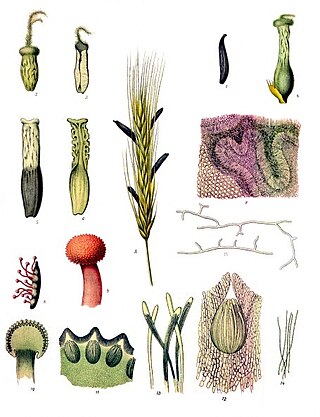
The Clavicipitaceae are a family of fungi within the order Hypocreales. A 2008 estimate placed 43 genera in the family, but a study in 2020 has increased this number to 50.

Beauveria is a genus of asexually-reproducing fungi allied with the ascomycete family Cordycipitaceae. Its several species are typically insect pathogens. The sexual states (teleomorphs) of Beauveria species, where known, are species of Cordyceps.

Metarhizium is a genus of entomopathogenic fungi in the Clavicipitaceae family. With the advent of genetic profiling, placing these fungi in proper taxa has now become possible. Most turn out to be the asexual forms (anamorphs) of fungi in the phylum Ascomycota, including Metacordyceps spp.
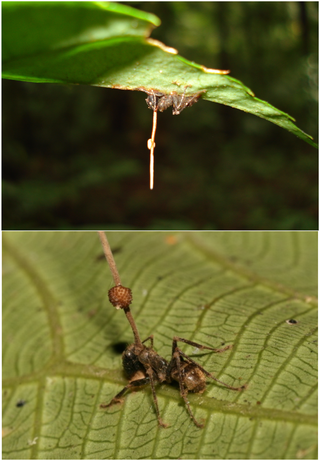
Ophiocordycipitaceae is a family of parasitic fungi in the Ascomycota, class Sordariomycetes. It was updated in 2020.

Ophiocordyceps is a genus of fungi within the family Ophiocordycipitaceae. The widespread genus, first described scientifically by British mycologist Tom Petch in 1931, contains about 140 species that grow on insects. Anamorphic genera that correspond with Ophiocordyceps species are Hirsutella, Hymenostilbe, Isaria, Paraisaria, and Syngliocladium.
Podonectria is a genus in the monotypic Podonectriaceae family of fungi. They are parasitic fungus on scale insects, other fungi, or on substrates that had previously colonized by other fungi.
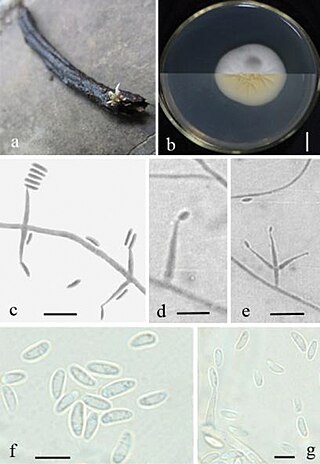
Lecanicillium is a genus of fungi in the order Hypocreales and is described as anamorphic Cordycipitaceae; 21 species are currently described. Some of these entomopathogenic fungus species were previously widely known as Verticillium lecanii (Zimmerman) Viegas. This genus was first named and introduced by Rasoul Zare (IRIPP) and Walter Gams (CBS).

Purpureocillium lilacinum is a species of filamentous fungus in the family Ophiocordycipitaceae. It has been isolated from a wide range of habitats, including cultivated and uncultivated soils, forests, grassland, deserts, estuarine sediments and sewage sludge, and insects. It has also been found in nematode eggs, and occasionally from females of root-knot and cyst nematodes. In addition, it has frequently been detected in the rhizosphere of many crops. The species can grow at a wide range of temperatures – from 8 to 38 °C for a few isolates, with optimal growth in the range 26 to 30 °C. It also has a wide pH tolerance and can grow on a variety of substrates. P. lilacinum has shown promising results for use as a biocontrol agent to control the growth of destructive root-knot nematodes.
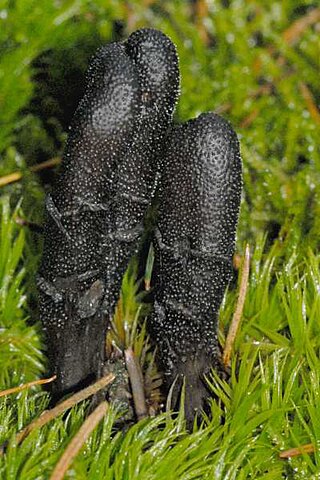
Tolypocladium is a genus of fungi within the family Ophiocordycipitaceae. It includes species that are parasites of other fungi, insect pathogens, rotifer pathogens and soil inhabiting species with uncertain ecological roles. Tolypocladium was originally circumscribed as a genus containing anamorphic fungi. It was later determined that some Cordyceps-like teleomorphic fungi were the teleomorphs of Tolypocladium species. These species were considered to belong in the genus Cordyceps until molecular phylogenetics studies found these species to be more closely related to Ophiocordyceps and were considered to belong in that genus before they were transferred to the new genus Elaphocordyceps by Sung and colleagues in 2007. However, under the ICN's 2011 "one fungus, one name" principle, fungi can not have different names for their anamorphic and teleomorphic stages if they are found to be the same taxon. Quandt and colleagues formally synonymized Tolypocladium and Elaphocordyceps in 2014. Quandt and colleagues also synonymized the anamorphic genus Chaunopycnis with Tolypocladium. The immunosuppressant drug ciclosporin was originally isolated from Tolypocladium inflatum, and has since been found in other species of Tolypocladium, some of which were formerly placed in Chaunopycnis.
Lecanicillium muscarium is the approved name of an entomopathogenic fungus species, that was previously widely known as Verticillium lecanii (Zimmerman) Viegas), but is now understood to be an anamorphic form in the Cordyceps group of genera in the Cordycipitaceae. It now appears that isolates formerly classified as V. lecanii could be L. attenuatum, L. lecanii, L. longisporum, L. muscarium or L. nodulosum. For example, several recent papers, such as Kouvelis et al. carried out mitochondrial DNA studies, refer to this name.
Lecanicillium longisporum is the approved name of an entomopathogenic fungus species, that was previously widely known as Verticillium lecanii (Zimmerman) Viegas, but is now understood to be an anamorphic form in the Cordyceps group of genera in the Cordycipitaceae. It now appears that isolates formerly classified as V. lecanii could be L. attenuatum, L. lecanii, L. longisporum, L. muscarium or L. nodulosum.
Ophiocordyceps myrmecophila is a species of fungus that parasitizes insect hosts, in particular members of the order Hymenoptera.

Cordyceps militaris is a species of fungus in the family Cordycipitaceae, and the type species of the genus Cordyceps. It was originally described by Carl Linnaeus in 1753 as Clavaria militaris. There are hundreds of species of cordyceps fungi. Special characteristics of Cordyceps Militaris are its use in traditional Chinese medicine, modern pharmaceuticals, and its relationship with insects and how it disperses.

Ophiocordyceps formicarum is an entomopathogenic fungus belonging to the order Hypocreales (Ascomycota) in the family Ophiocordycipitaceae. The fungus was first described by mycologist George S. Kobayashi in 1939 as a species of Cordyceps. Originally found in Japan growing on an adult Hercules ant, it was reported from Guizhou, China, in 2003. It was transferred to the new genus Ophiocordyceps in 2007 when the family Cordycipitaceae was reorganized. A technique has been developed to grow the fungus in an agar growth medium supplemented with yeast extract, inosine, and glucose.

Purpureocillium atypicola is a species of fungus, previously known as Nomuraea atypicola, in the family Ophiocordycipitaceae with no subspecies listed in the Catalogue of Life. There are records of this mushroom from Japan, Australia and New Zealand.

Cordyceps locustiphila is the basionym and teleomorph of the fungi Beauveria locustiphila, a species of fungus in the family Cordycipitaceae. and is a species within the genus Cordyceps. It was originally described in by Henn in 1904. C. locustiphila is an entomopathogen and obligate parasite of the grasshopper species within the genus Colpolopha or Tropidacris, and as such is endemic to South America. The scientific name is derived from its close relationship with its host, being named after locusts. The fungi was renamed to Beauveria locustiphila in 2017 following research into the family Cordycipitaceae. Following the loss of the species type specimen, new studies were conducted that now recommend that the fungi be divided into 3 species. C. locustiphila, C. diapheromeriphila, and C. acridophila.













